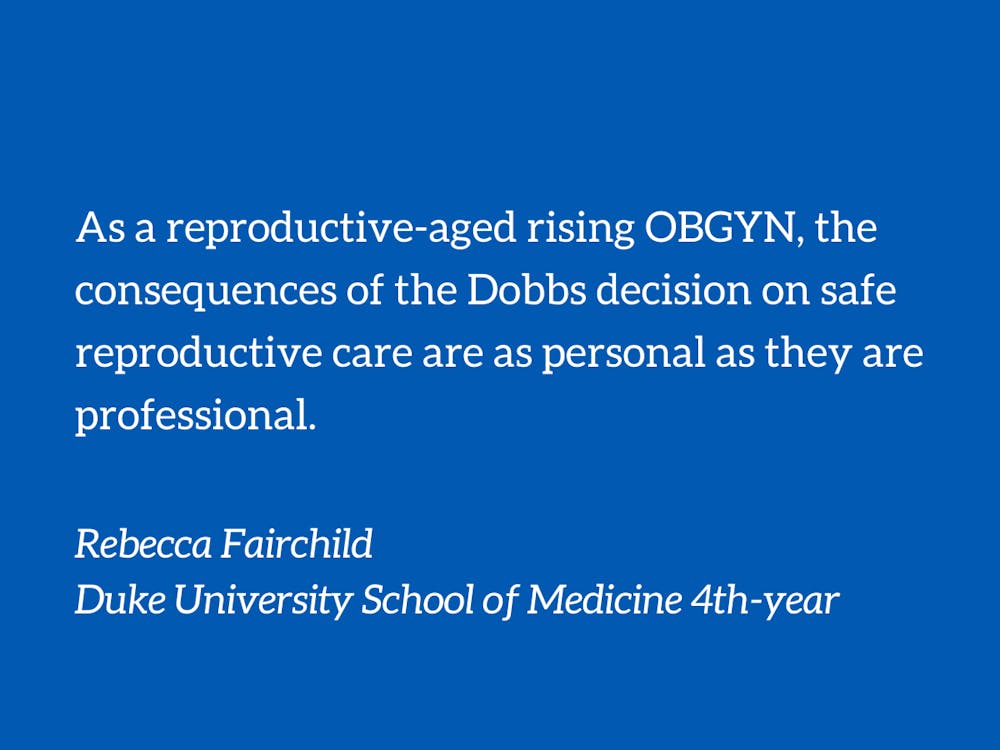This guest column is part of a series of three OP-Eds about abortion care access in North Carolina submitted by members of the Reproductive Health Care Post-Roe (2023-2024) Bass Connections project. More information on the project and provider testimonies can be found on the project’s website.
As a medical student, the first thing I promise to my patients and to society is to “do no harm.” It’s an ironic pledge. How do we learn to “do no harm” when we are taught by a medical system that inflicts harm on patients every day? Harm occurs when essential medications are too costly for patients to afford. Harm is done when provider biases cloud decision-making. Legislators inflict harm when abortion restrictions deny people bodily autonomy, and force providers to deny lifesaving care.
Although it is clear that abortion restrictions cause inadequate care, it is harder to understand what optimal care would be—many of us never get to see it. Recent scholarship shows that 48% of medical students train in states with restrictive abortion legislation. In these environments, students have little opportunity to learn the clinical nuances of abortion care, meet patients seeking abortions, and work with the providers most expert in abortion medicine.
When we lack formal education in abortion care, we learn instead through less expert sources, such as clinicians who do not perform abortions. This is a problem because doctors outside of OBGYN are not routinely updated on the latest data and practice standards in gynecologic care and their teaching can be outdated, unclear and misleading. As future physicians, we all carry what we learn, or fail to learn, into our conversations with patients and our students. Equipped with only a shaky understanding of abortion care, we not only risk mismanaging our patients but also risk perpetuating this cycle of misinformation that causes patient harm well into the future.
I am lucky; I have been able to train in an abortion clinic as a medical student. The benefits of this clinical exposure were immediately apparent. Through counseling patients about abortion medications and watching providers deftly complete procedures, I gained comfort with the nuances of this medicine and an appreciation of the safety of abortions. Sitting with patients, I was reminded of the complexity and weight of the personal, economic, health, familial factors and value systems that influence these decisions. Making these decisions, nobody benefited from the litany of state-mandated “counseling”, which is belittling, works against evidence-based medicine, and is out of touch with the patient experience. It would be hard for any medical student to walk away from these experiences without the fundamental understanding that abortions are safe, deeply complex and personal and that regulations are painfully misaligned with patient needs.
Even with clinical exposure to abortion, there are still gaps in medical education. In our training, we spend only a handful of days in abortion clinics and are in one hospital system, making it hard to contextualize the care we see with what existed historically or is available in different political climates. Further, we only meet the patients who were able to access care. We lose the voices of the people who are most deeply impacted — the patient who found out too late and is forced to cross state lines, the person without transportation to a care center, and so many others who have been systematically excluded from care. Because we enter this space so briefly, it is difficult — impossible even — to appreciate the gravity of what has been lost.
These factors weigh heavily when selecting where to train for residency. Across medical specialties, residents avoid training in states with abortion restrictions due to concerns of compromised training, moral distress of denying care and their personal reproductive safety. These factors persist after the completion of training, with documented flight of physicians from states with abortion restrictions. In fact, such states have 32% fewer OBGYNs per births than states that protect abortions. These factors compound so that the people most likely to be harmed by dangerous abortion policy may also have the least access to doctors.
As a reproductive-aged rising OBGYN, the consequences of the Dobbs decision on safe reproductive care are as personal as they are professional. For young people, the capacity to become pregnant carries inherent risks which are becoming more dangerous in regions where legislation restricts evidence-based reproductive care. With the increasingly fragmented map of reproductive care, abortion legislation impacts the places we choose to move, the jobs we take and our safety in the places we settle.
While this landscape is deeply unsettling, power remains in reproductive advocacy. For people entering medical school, there is opportunity to push for change through engaging with Med Students for Choice, conducting research on abortion access, and working with curriculum committees to push for formal abortion education. For all people, continue to learn and talk about reproductive justice and abortion, make educated votes, and engage with and uplift the work of groups such as SisterSong to push for reproductive justice policy. With these efforts, not only are you advocating for the patients needing care now, but you are fighting for a workforce equipped to care for birthing people for the years and decades to come.
Rebecca Fairchild is a 4th-year medical student at the Duke University School of Medicine and a member of the Reproductive Health Care Post-Roe (2023-2024) Bass Connections Project.
Get The Chronicle straight to your inbox
Signup for our weekly newsletter. Cancel at any time.

